
A pediatric physical examination is a crucial tool for assessing a child’s overall health, growth, and development. Regular check-ups help identify potential issues early, ensuring timely interventions and promoting optimal well-being. This comprehensive approach lays the foundation for preventive care, guiding healthcare providers in addressing physical, emotional, and developmental needs effectively.
1.1 Importance of Regular Check-Ups
Regular pediatric check-ups are essential for monitoring a child’s growth, development, and overall health. These visits allow healthcare providers to detect potential issues early, preventing complications and ensuring timely interventions. Check-ups also provide opportunities for vaccinations, screenings, and guidance on nutrition, safety, and hygiene. Parents can address concerns about their child’s development, behavior, or physical well-being. Early identification of abnormalities, such as growth delays or developmental milestones, enables appropriate referrals and treatments. Regular check-ups foster a proactive approach to health, promoting long-term well-being and giving parents peace of mind. They are a cornerstone of preventive care, ensuring children thrive physically, emotionally, and socially.
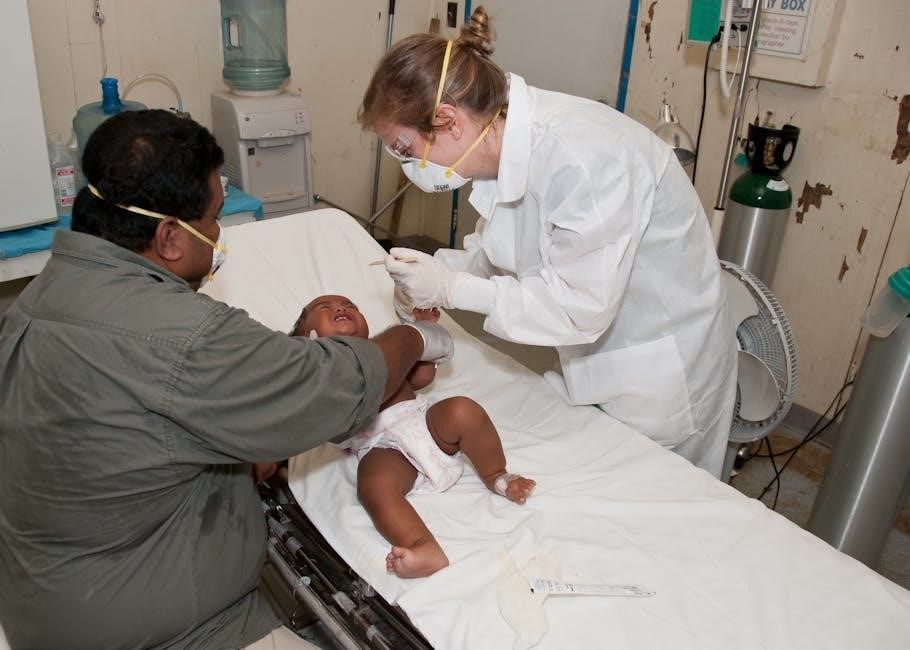
1.2 Role of Physical Examination in Pediatric Care
The physical examination plays a vital role in pediatric care, serving as a cornerstone for diagnosing and managing health conditions. It provides a comprehensive assessment of a child’s physical, developmental, and emotional well-being. Through observation, palpation, and other techniques, healthcare providers can identify abnormalities, track growth patterns, and assess developmental milestones. The examination also helps in detecting potential issues before symptoms arise, enabling early intervention. Regular physical exams reassures parents and builds trust between the child and healthcare provider. Additionally, they offer opportunities to address concerns, provide guidance, and promote preventive care. The physical exam is not just a diagnostic tool but also a way to foster healthy habits and ensure a child’s optimal development. It remains a fundamental aspect of pediatric care, guiding personalized treatment plans and long-term health outcomes.

Preparation for the Pediatric Physical Examination
Preparing for a pediatric exam involves creating a calming environment, gathering essential tools, and ensuring the child and parents are informed and ready for the assessment.
2.1 Creating a Comfortable Environment for the Child
Creating a comfortable environment for a pediatric physical examination is vital to ensure the child’s cooperation and reduce anxiety. A calm, child-friendly space with age-appropriate toys or distractions can help the child feel at ease. The room should be well-lit and at a comfortable temperature. Using non-threatening language and explaining each step in a simple manner can alleviate fears. Involving parents or caregivers in the process, allowing the child to sit on their lap if needed, can provide emotional support. A positive first impression helps build trust, making the examination process smoother and more effective for both the child and healthcare provider.
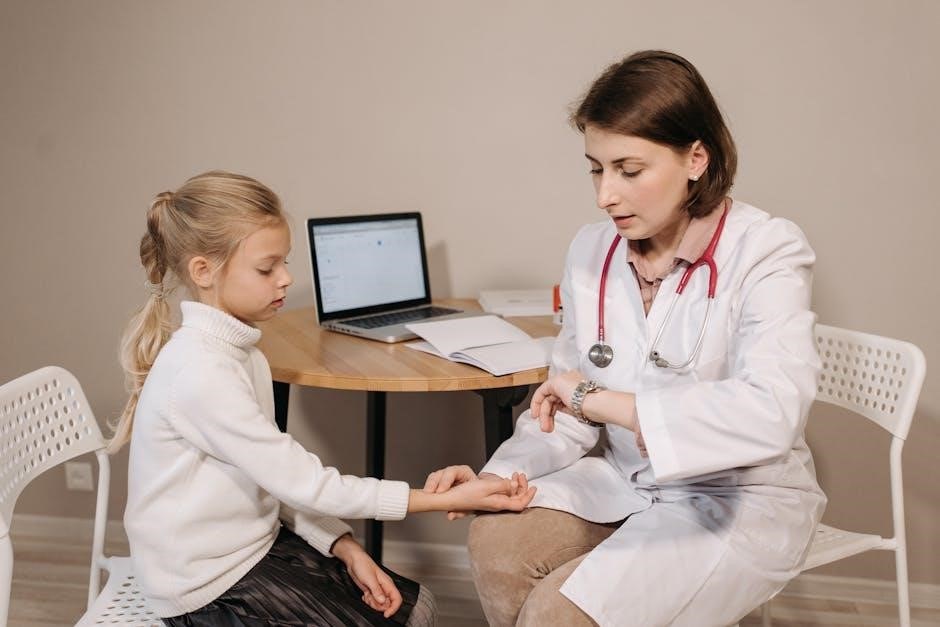
2.2 Essential Tools and Equipment Needed
The pediatric physical examination requires specific tools to ensure accuracy and effectiveness. Essential equipment includes a stethoscope, blood pressure cuff (in various sizes for different age groups), an otoscope for ear examinations, and an ophthalmoscope for eye assessments. A digital thermometer is necessary for measuring body temperature accurately. Additional tools include a reflex hammer for assessing neurological responses, a growth chart to monitor development, and a tape measure for head and abdominal circumference measurements. Gloves and a well-lit environment are also crucial for a thorough examination. Having these tools organized and readily available helps streamline the process, ensuring a comprehensive and stress-free experience for the child.
2.3 Preparing the Child and Parents for the Exam
Preparing the child and parents for the physical examination is vital to ensure a smooth and stress-free experience. Clear communication is key; explaining the process in simple, age-appropriate terms helps reduce anxiety. Creating a calm and friendly environment, such as using a child-friendly room with toys, can make the child feel more comfortable. Parents should be encouraged to stay with their child to provide reassurance. It’s also important to address any concerns or questions the parents may have beforehand. Ensuring the child is well-rested and fed can help them cooperate during the exam. Providing guidance on what to expect and involving parents in the process fosters trust and collaboration, making the examination more effective. This preparation also helps in gathering accurate information about the child’s health history and behaviors.
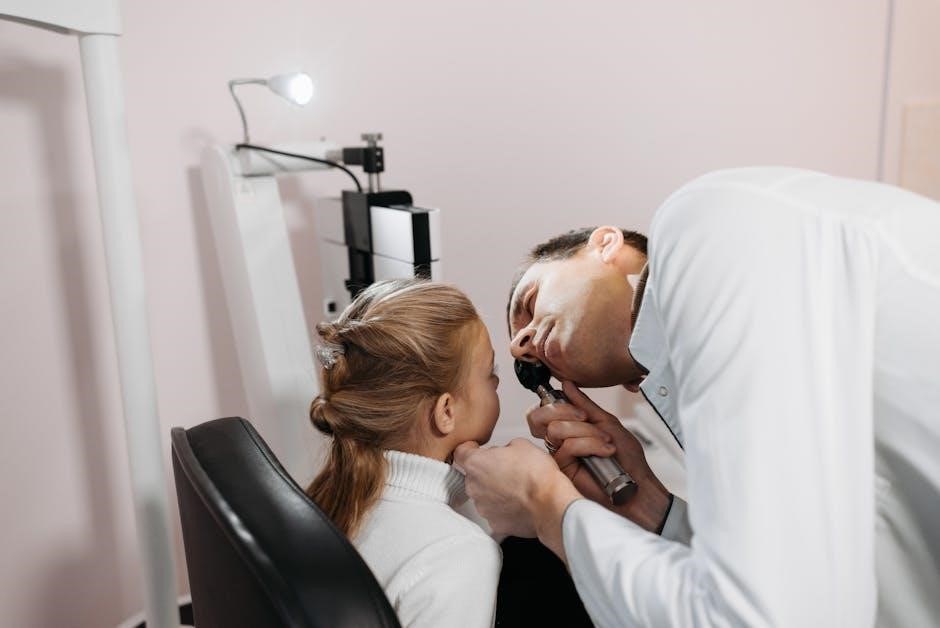
Components of a Comprehensive Pediatric Physical Exam
A comprehensive pediatric physical exam includes assessing general appearance, vital signs, and systems such as cardiovascular, respiratory, abdominal, musculoskeletal, neurological, and skin. Each component ensures thorough evaluation.
3.1 General Appearance and Vital Signs
The general appearance of a child provides initial insights into their health status. Observations include posture, hydration, and overall comfort. Vital signs such as height, weight, temperature, heart rate, respiratory rate, and blood pressure are measured to establish baseline values. These metrics are age-specific and critical for early detection of abnormalities. Abnormal findings may indicate underlying conditions, such as fever suggesting infection or tachycardia signaling distress. Accurate measurement and interpretation of these signs are essential for forming a comprehensive assessment. Regular tracking of growth parameters helps monitor developmental progress and identify deviations from expected norms. This foundational evaluation guides further examination and informs diagnostic decisions, ensuring a holistic approach to pediatric care.
3.2 Head and Neck Examination
The head and neck examination begins with inspecting for signs of abnormalities, such as swelling, asymmetry, or unusual posture. The scalp is checked for lesions or developmental issues. Eyes are assessed for alignment, with strabismus or nystagmus noted. Ears are examined for position, discharge, or signs of infection. The nose and mouth are inspected for congestion, unusual discharge, or oral abnormalities. The throat is evaluated for redness, swelling, or exudate. Palpation of the face, sinuses, and lymph nodes helps identify tenderness or enlargement. Otoscopic and ophthalmoscopic exams provide detailed views of the tympanic membranes and retina. Any abnormalities may indicate systemic or localized conditions, guiding further diagnostic steps. This thorough assessment ensures a comprehensive evaluation of the head and neck, vital for early detection of potential health issues in pediatric patients.
3.3 Cardiovascular System Assessment
The cardiovascular assessment begins with measuring blood pressure and heart rate, noting any irregularities. Palpation checks for thrills or murmurs, which may indicate congenital defects. Auscultation focuses on heart sounds, detecting abnormalities like gallops or rubs. Peripheral pulses are evaluated for strength and rhythm. Signs of heart failure, such as edema or tachypnea, are observed; In pediatric patients, capillary refill time is assessed to gauge circulatory status. Any unusual sounds or symptoms warrant further investigation. Additional tests like EKG or echocardiogram may be recommended for detailed evaluation. This thorough approach ensures early detection of cardiovascular issues, crucial for timely intervention and management in children.
3.4 Respiratory System Evaluation
The respiratory system evaluation begins with inspection, noting chest shape, breathing patterns, and respiratory rate. Auscultation is performed to assess breath sounds, identifying abnormalities like wheezing, crackles, or decreased air movement. Percussion may be used to check for hyperresonance or dullness, indicating conditions such as hyperinflation or consolidation. Palpation assesses for tactile fremitus and subcutaneous air. Oxygen saturation is measured, and signs of respiratory distress, such as retractions or nasal flaring, are noted. Cough characteristics and breath sounds during coughing are evaluated. In pediatric patients, the assessment also includes observing for age-appropriate respiratory rates and effort. Any abnormalities warrant further diagnostic testing, such as a chest X-ray or spirometry, to ensure timely intervention and management of respiratory conditions.
3.5 Abdominal Examination Techniques
The abdominal examination in pediatric patients involves a systematic approach to assess organ function and detect potential abnormalities. Inspection begins with observing the abdomen for distension, scars, or visible masses. Auscultation is performed to listen for bowel sounds, which should be active and normal in rhythm. Percussion is used to assess liver and spleen size, noting any areas of tenderness. Palpation is gentle and gradual, starting with light touch to identify areas of discomfort before applying deeper pressure. Special attention is given to the liver edge, spleen, and kidneys. The examiner also checks for rebound tenderness or guarding, which may indicate peritoneal irritation. In pediatric cases, a calm and reassuring approach is essential to minimize anxiety and ensure accurate findings. These techniques help identify gastrointestinal, hepatic, or renal issues early, guiding further diagnostic steps if needed.
3.6 Musculoskeletal System Inspection
The musculoskeletal examination in pediatric patients evaluates the structure and function of bones, joints, and muscles. The process begins with observation, assessing posture, gait, and overall alignment. The examiner checks for signs of deformities, such as scoliosis or clubfoot, and notes any limitations in range of motion. Palpation is used to detect tenderness, swelling, or warmth around joints, which may indicate inflammation. Strength and muscle tone are assessed through resistance tests, ensuring age-appropriate development. In infants, the examiner may check for hip dislocation using the Ortolani or Barlow maneuver. Special attention is given to areas of common injury or growth-related pain, such as the knees or spine. This thorough inspection helps identify developmental abnormalities, injuries, or conditions like juvenile arthritis, allowing for early intervention and management. A gentle and child-friendly approach is crucial to ensure cooperation and accurate assessment.
3.7 Neurological System Assessment
The neurological examination in pediatric patients evaluates central and peripheral nervous system function. It begins with assessing mental status, including alertness, behavior, and cognitive development. Cranial nerve function is tested to check for abnormalities in vision, hearing, facial movements, and swallowing. Motor function is assessed by observing muscle tone, strength, and coordination through activities like walking or drawing. Reflexes, including deep tendon and primitive reflexes, are evaluated to ensure proper neurological maturation. Sensory function is tested for pain, touch, and proprioception. Developmental milestones, such as sitting, standing, or speaking, are noted to identify delays or abnormalities. Specialized tools like the Mini-Mental State Examination may be used for older children. The examination is tailored to the child’s age, ensuring a non-threatening environment to maximize cooperation and accuracy. Red flags include developmental delays, abnormal reflexes, or loss of skills, warranting further investigation.
3.8 Skin and Lymph Node Examination
The skin and lymph node examination is essential in pediatric assessments. It begins with observing skin color, texture, and hydration, noting any rashes, lesions, or signs of infection. Pigmentation, birthmarks, or unusual marks are documented. Lymph nodes are palpated in key areas like the cervical, axillary, inguinal, and femoral regions to check for enlargement or tenderness. This helps identify potential infections, inflammatory conditions, or systemic diseases. Developmental conditions, such as nevi or eczema, are noted. The examination also screens for signs of abuse or neglect. Red flags include widespread rashes, unexplained lymphadenopathy, or signs of allergic reactions. Proper technique ensures accuracy, while parental guidance aids in identifying new or changing skin lesions. This assessment provides critical insights into the child’s overall health and immune status.
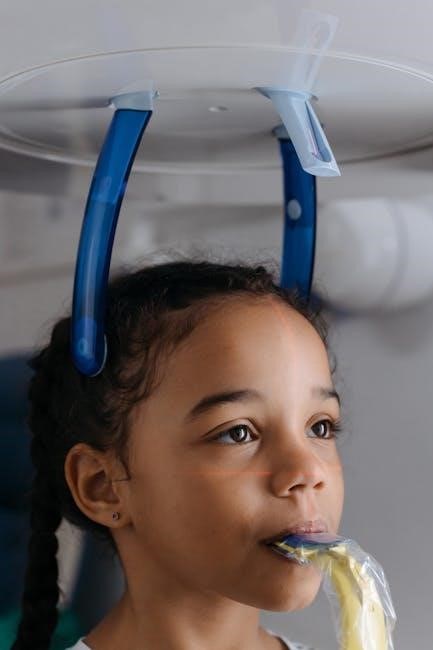
Documentation and Interpretation of Findings
Accurate documentation of physical examination findings ensures precise interpretation and informed decision-making. Clear, concise records guide future care, track progress, and facilitate effective communication among healthcare providers.
4.1 Accurate Record-Keeping Practices
Accurate record-keeping is essential in pediatric care to ensure continuity and consistency in treatment. Clear and concise documentation of findings, including vital signs, developmental milestones, and abnormalities, helps track a child’s progress over time. Standardized formats should be used to maintain uniformity, making it easier for healthcare providers to review and interpret records. Digital health records enhance accessibility and reduce errors, while maintaining patient confidentiality. Regular audits and training ensure adherence to best practices, promoting high-quality care and legal compliance. By prioritizing precise documentation, healthcare providers can deliver more effective and personalized treatment plans for children.
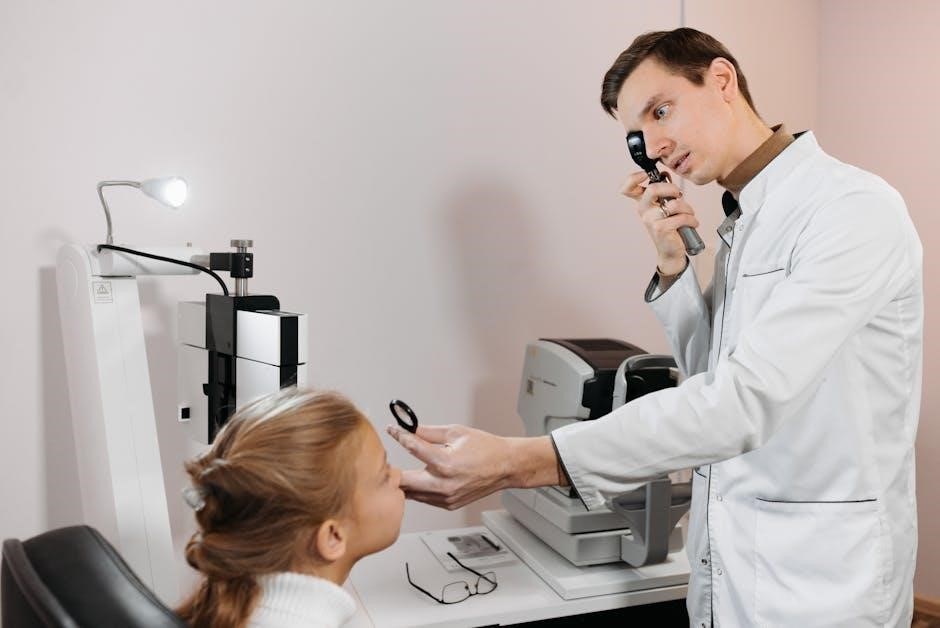
4.2 Interpreting Normal and Abnormal Findings
Interpreting normal and abnormal findings is a critical skill in pediatric care. Normal findings, such as age-appropriate growth metrics, typical reflexes, and clear lung sounds, provide reassurance and guide routine care. Abnormal findings, like irregular heart rhythms or delayed developmental milestones, signal potential issues requiring further investigation. Accurate interpretation relies on understanding pediatric norms, such as expected vital sign ranges and growth chart percentiles. Clinical judgment is essential to distinguish pathological conditions from benign variations. For example, a heart murmur may indicate a congenital defect, while a common cold explains nasal congestion. Documenting findings and comparing them over time helps track progression and inform treatment decisions, ensuring timely interventions for optimal outcomes.
4.3 Reporting and Referral Guidelines
Clear reporting and appropriate referrals are vital for ensuring comprehensive care. After documenting findings, healthcare providers must communicate results effectively to parents or guardians, highlighting normal results and addressing concerns. Referral guidelines dictate when specialist consultation is needed, such as for abnormal heart sounds or developmental delays. Timely referrals prevent complications and improve outcomes. For instance, a child with persistent respiratory issues may need a pulmonologist evaluation. Documentation should be concise, with key findings and recommendations clearly outlined. Electronic health records facilitate seamless communication between providers. Follow-up is essential to monitor progress and adjust treatment plans as needed. Adhering to these guidelines ensures coordinated, patient-centered care, optimizing health outcomes for children.
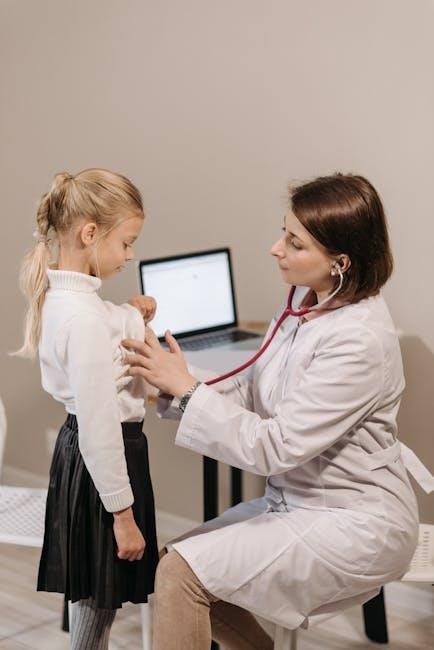
Special Considerations in Pediatric Exams
Pediatric exams require special considerations, such as adapting techniques for children with disabilities, ensuring cultural sensitivity, and recognizing red flags for serious conditions like developmental delays or abuse.
5.1 Examining Children with Special Needs
Examining children with special needs requires a tailored approach to ensure comfort and accuracy. Use simple, clear communication and adapt techniques to their abilities. Incorporate visual aids or familiar objects to reduce anxiety. Allow flexibility in the examination process, such as breaking it into shorter sessions or adjusting the order of assessment. Involve parents or caregivers for support and additional insights. Be mindful of sensory sensitivities and physical limitations. Document any assistive devices or accommodations used. Ensure the environment is accessible and non-threatening. Focus on building trust to make the experience positive and stress-free for the child. This approach fosters cooperation and provides accurate assessments tailored to their unique needs.
5.2 Cultural Sensitivity in Pediatric Care
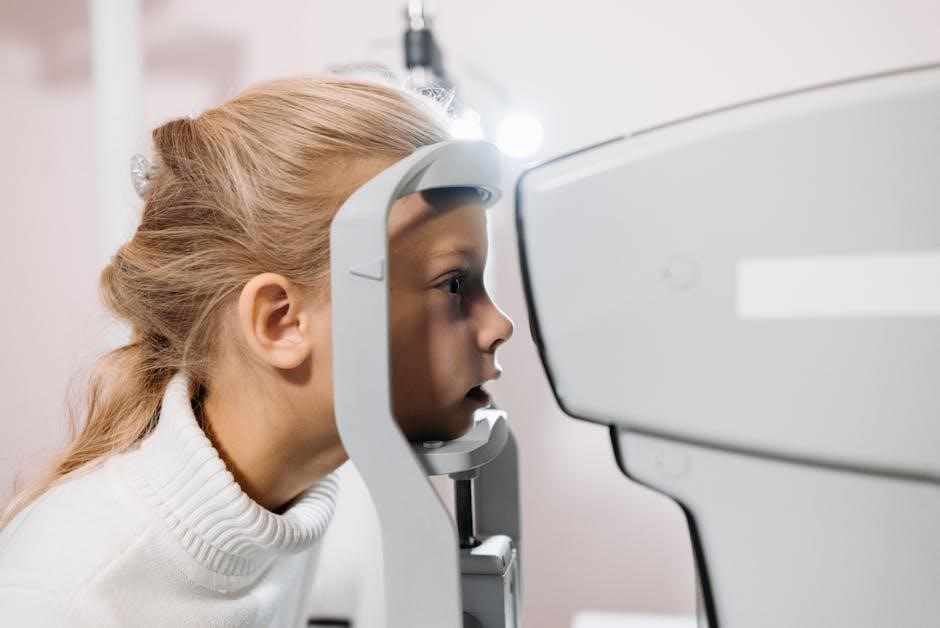
Cultural sensitivity is essential in pediatric care, ensuring respectful and effective interactions with diverse families. Recognize and respect cultural beliefs, practices, and values that may influence health perceptions and behaviors. Use clear, simple language and interpretive services when needed. Be aware of non-verbal cues and adapt communication styles to build trust. Consider cultural differences in pain expression, medical practices, and decision-making processes. Incorporate culturally appropriate assessment techniques and tools. Engage families in care decisions, respecting their preferences and traditions. Foster an inclusive environment that values diversity, enhancing the quality of care provided. This approach promotes understanding, cooperation, and positive health outcomes for children from all backgrounds. Continuous education on cultural competence is vital for healthcare providers to deliver empathetic and patient-centered care.
5.3 Recognizing Red Flags in Physical Examination
Recognizing red flags during a pediatric physical examination is critical for identifying potential serious conditions early. Key red flags include abnormal growth patterns, delayed developmental milestones, and signs of distress such as tachypnea or tachycardia. Vital signs outside normal ranges, like fever or low blood pressure, warrant immediate attention. Physical findings such as jaundice, swelling, or unusual reflexes may indicate underlying issues. Parents’ concerns should never be dismissed, as they often provide valuable insights. Red flags guide further diagnostic testing or referrals to specialists. Timely identification ensures appropriate interventions, improving outcomes for children. Clinicians must remain vigilant, combining clinical judgment with evidence-based guidelines to prioritize patient safety and effective care.
Pediatric physical examinations remain vital in modern healthcare, integrating technology and evidence-based practices to enhance diagnostic accuracy and personalized care. Continuous learning ensures clinicians stay updated, addressing emerging challenges and improving outcomes for children.
6.1 The Role of Physical Exam in Modern Pediatrics
The physical examination remains a cornerstone of pediatric care, complementing advanced diagnostic tools. It ensures personalized, patient-centered care, allowing clinicians to detect subtle abnormalities early. By integrating clinical findings with technological advancements, the physical exam enhances diagnostic accuracy and therapeutic planning. It fosters trust between families and healthcare providers, addressing emotional and developmental concerns. As pediatrics evolves, the physical exam adapts, incorporating evidence-based practices to improve outcomes. Continuous learning and skill refinement are essential for clinicians to maintain proficiency in this vital skill, ensuring its relevance in modern, technology-driven healthcare settings. The physical exam bridges the gap between art and science in pediatrics, remaining indispensable for holistic child care.

6.2 Continuous Learning and Skill Development
Continuous learning and skill development are vital for healthcare professionals in pediatric care. Staying updated with the latest research, guidelines, and techniques ensures accurate diagnoses and effective care. Clinicians must engage in ongoing education, such as workshops, online courses, and hands-on training, to refine their physical examination skills. Regular practice and feedback from experienced mentors enhance proficiency. Additionally, integrating new technologies and evidence-based practices into daily routines keeps professionals aligned with modern standards. Continuous improvement not only sharpens clinical abilities but also fosters confidence and competence, ultimately benefiting patient outcomes; By prioritizing lifelong learning, pediatric care providers can adapt to evolving challenges and deliver high-quality, compassionate care.